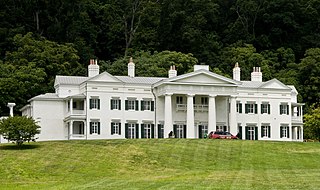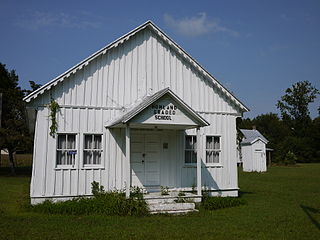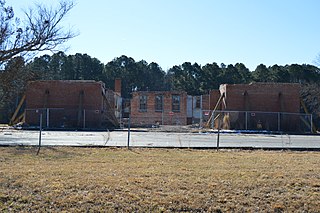
Courtland is an incorporated town in Southampton County, Virginia, United States. It is the county seat of Southampton County.

Montross is a town in Westmoreland County, Virginia, United States. The population was 553 at the 2020 census. It is the county seat of Westmoreland County. Located in the historic Northern Neck of Virginia, Montross is near the George Washington Birthplace National Monument and the Stratford Hall Plantation. The town's slogan is return to the village.

The Northern Neck is the northernmost of three peninsulas on the western shore of the Chesapeake Bay in the Commonwealth of Virginia. The Potomac River forms the northern boundary of the peninsula; the Rappahannock River demarcates it on the south. The land between these rivers was formed into Northumberland County in 1648, prior to the creation of Westmoreland County and Lancaster County. The Northern Neck encompasses the following Virginia counties: Lancaster, Northumberland, Richmond, King George and Westmoreland; it had a total population of 50,158 as of the 2020 census.

Morven Park is a 1,000-acre historic estate and horse park in Leesburg, Virginia, United States. Located on the grounds are the Morven Park Mansion, the Winmill Carriage Museum, formal boxwood gardens, miles of hiking and riding trails, and athletic fields. The park is also home to the Museum of Hounds and Hunting of North America with displays of art, artifacts and memorabilia about the sport of foxhunting.

The Robert Russa Moton Museum is a historic site and museum in Farmville, Prince Edward County, Virginia. It is located in the former Robert Russa Moton High School, considered "the student birthplace of America's Civil Rights Movement" for its initial student strike and ultimate role in the 1954 Brown v. Board of Education case desegregating public schools. It was designated a National Historic Landmark in 1998, and is now a museum dedicated to that history. In 2022 it was designated an affiliated area of Brown v. Board of Education National Historical Park. The museum were named for African-American educator Robert Russa Moton.

Ralph Bunche High School was a school constructed in 1949 as a result of Civil Action 631 to provide "separate but equal" education for African-American students in King George County, Virginia. The school operated until 1968 when King George High School was completed and the county's schools integrated. The school was named for Ralph Bunche, an African-American educator, diplomat and Nobel Prize winner.

Westmoreland State Park lies within Westmoreland County, Virginia. The park extends about one and a half miles along the Potomac River and covers 1,321 acres. The Horsehead Cliffs provide visitors with a panoramic view of the Potomac River, and lower levels feature fossils and beach access. The park offers hiking, camping, cabins, fishing, boating and swimming, although mechanical issues have kept the swimming pool closed since 2021. Located on the Northern Neck Peninsula, the park is close to historical sites featuring earlier eras: George Washington's birthplace and Stratford Hall, the birthplace of Robert E. Lee.

Spence's Point is a historic estate on the Potomac River near Westmoreland, Virginia. Also known as the John R. Dos Passos Farm, it was the home of writer John Dos Passos (1896–1970) for the last 25 years of his life. It was declared a National Historic Landmark in 1971.

St. Peter's Episcopal Church is a historic Episcopal church located at the junction of VA 3 and VA 205 in historic Oak Grove, Westmoreland County, Virginia. Although the surrounding parish was created in the 17th century, the current brick structure, which was listed on the National Register of Historic Places in 2004, was consecrated in 1849, and planned to celebrate its 175th anniversary on May 31, 2024. Fire severely damaged the historic church on December 19, 2023.

Douglass High School or Douglass Alternate school was built in 1941 in what was then a rural area just outside Leesburg, Virginia as the first high school for African-American students in Loudoun County. The school was built on land purchased by the black community for $4,000 and conveyed to the county for $1. It was the only high school for African-American students until the end of segregation in Loudoun County in 1968.

The Howland Chapel School is a historic school building for African-American students located near Heathsville, Northumberland County, Virginia. It was built in 1867, and is a one-story, gable fronted frame building measuring approximately 26 feet by 40 feet. It features board-and-batten siding and distinctive bargeboards with dentil soffits. The interior has a single room divided by a later central partition formed by sliding, removable doors. The building is a rare, little-altered Reconstruction-era schoolhouse built to serve the children of former slaves. Its construction was funded by New York educator, reformer and philanthropist Emily Howland (1827-1929), for whom the building is named. It was used as a schoolhouse until 1958, and serves as a museum, community center and adult-education facility.

The Second Union School is a historic Rosenwald school building for African-American children located near Fife, in western Goochland County, Virginia. It was built in 1918, as a two-teacher school, near Second Union Baptist Church, which had been founded in 1865 as an independent black congregation.

Augusta County Training School, also known as Cedar Green School, is a historic public school building located at Cedar Green, Augusta County, Virginia. It was built in 1938, and is a one-story, central-auditorium plan frame building with projecting classroom wings on each side of a recessed auditorium. It features a projecting entrance portico and steeply pitched roof in a vernacular Neo-Classical style. It opened as a "Training School," but was later used as an elementary school. It was the first consolidated school larger than two rooms built for African American students in Augusta County. The American Legion purchased the building in 1966 and remodeled it for their lodge.

Jericho School is a historic one-room school building located at Ruther Glen, Caroline County, Virginia.

Josephine City School is a historic school building for African-American children located at Berryville, Clarke County, Virginia. It was built about 1882, and is a rectangular, one-story, frame building with a gable roof and a four-bay side gable entrance facade. The school measures approximately 40 feet long and 30 feet wide. It is part of a school complex for African American children that included the Josephine City School; the 1930 brick Clarke County Training School; and a 1941 frame building that was constructed as additional agriculture classrooms. It was used as an elementary school until 1930, when it was moved a short distance from its original location, and used as the Clarke County Training School's home economics and agriculture classrooms. It was used for classrooms until 1971, when it was turned into storage space, after which it was converted into low/moderate-income elderly housing.

Number 18 School in Marshall is a historic one-room school located at Marshall, Fauquier County, Virginia. It was built about 1887, and is a rectangular frame building, covered with weatherboard, and resting on a stone foundation, with a metal gable roof with a centrally located brick stove flue. Atop the roof is a reconstructed cupola. It is the only surviving unimpaired one-room schoolhouse in Fauquier County. It was originally constructed for white students, then from the fall of 1910 to 1964, a school for African-American children.

Almshouse Farm at Machipongo, now known as the Barrier Islands Center, is a historic almshouse for Northampton County residents. Residents, also known as "inmates", included those sent for unpaid debts but also included homeless people, the mentally ill, orphans and those with diseases like tuberculosis and smallpox. "Inmates" were generally directed by the court to live at the almshouse. The Almshouse Farm served as the site for the Northampton County poorhouse for almost 150 years, from 1804 until 1952. African-Americans were housed in a separate building on the property located at Machipongo, Northampton County, Virginia. The oldest of the three main buildings was built about 1725, and is a 1 1/2-half story structure built in two parts, one brick and one frame, and probably predates the almshouse use of the property. The main building was built about 1840, and is a frame, two-story building in the vernacular Greek Revival style. It housed residents of the almshouse farm. A building dated to 1910, is a one-story frame building in a form resembling that of one-story frame school buildings from the same period and was specifically constructed to separately house African-American residents. There were 10 rooms for the black poor, and no in-house plumbing. This building was renovated in 2013 and now serves as the BIC Education Building. Also on the property are two contributing small, frame, late-19 or early 20th-century outbuildings. The Northampton County Almshouse Farm was in continuous operation between 1803 and 1952.

Holley Graded School is a historic school building for African American students located at Lottsburg, Northumberland County, Virginia. It was built in stages between about 1914 and 1933, and is a one-story, cross-shaped plan building. It features four identical-sized classrooms, a central passage, two cloakrooms and a kitchen. It was used as a schoolhouse until 1959, and subsequently used as a combination museum and adult-education facility.

Blenheim is a historic home located near Wakefield Corner, Westmoreland County, Virginia. It was built about 1781, and is a two-story, three-bay, Late Georgian style brick dwelling. It has a gable roof and two-story, frame wing. The house was built by the Washington family to replace the original family house at Wakefield soon after it burned on Christmas Day, 1779. The house was built for William Augustine Washington, the son of George Washington's half-brother Augustine Washington II.

Nansemond County Training School, also known as Southwestern High School, is a historic Rosenwald School for African-American students located at Suffolk, Virginia. It was built in 1924, and is a one-story building consisting of a central block with a recessed covered porch and flanking wings. It is capped with a tin hipped roof. Also on the property is the contributing cafeteria building that was later used as an extra classroom. It was built to house the first public black high school in Nansemond County, Virginia, and included both the primary and secondary grades. The school closed following the 1969–70 school year.
























